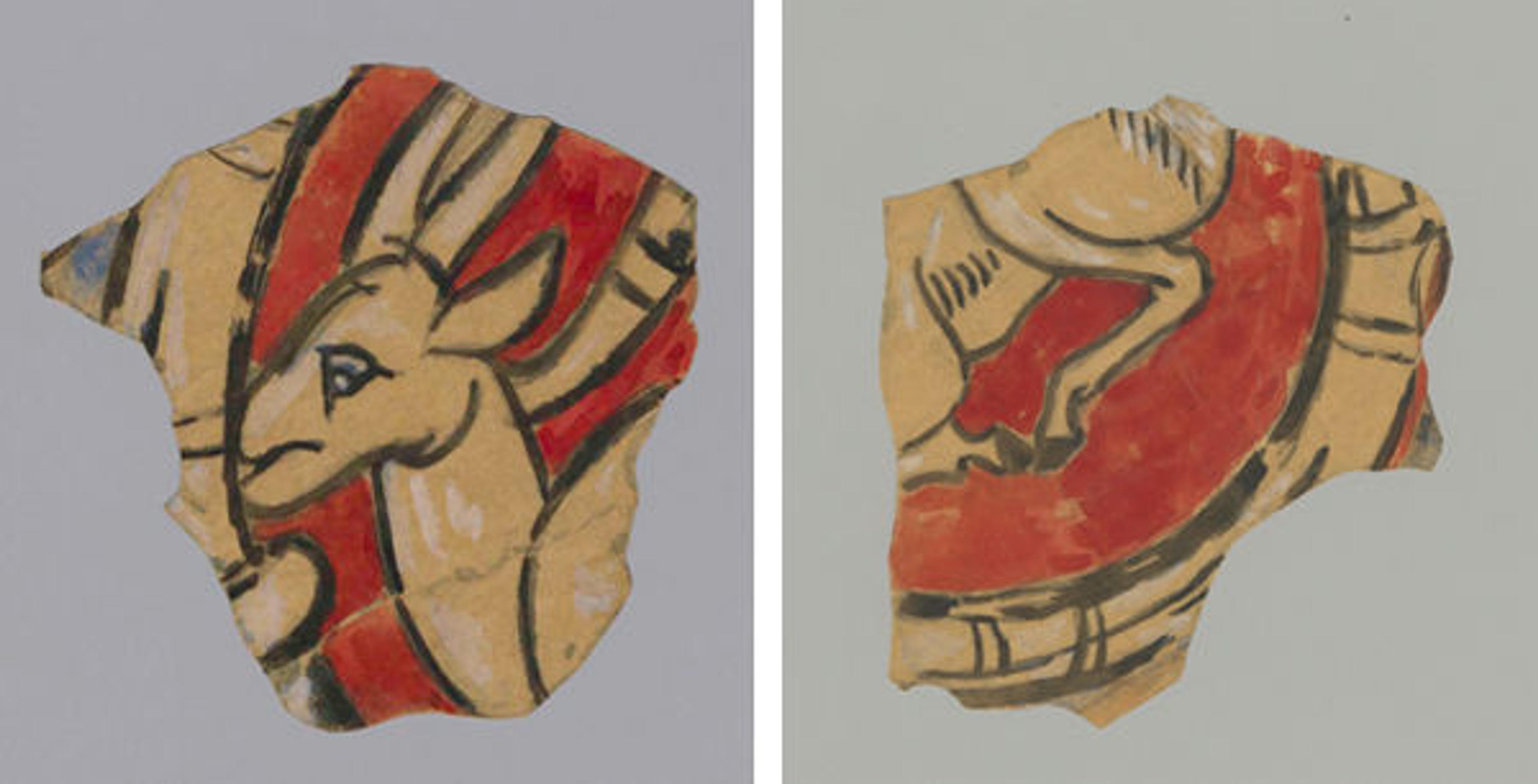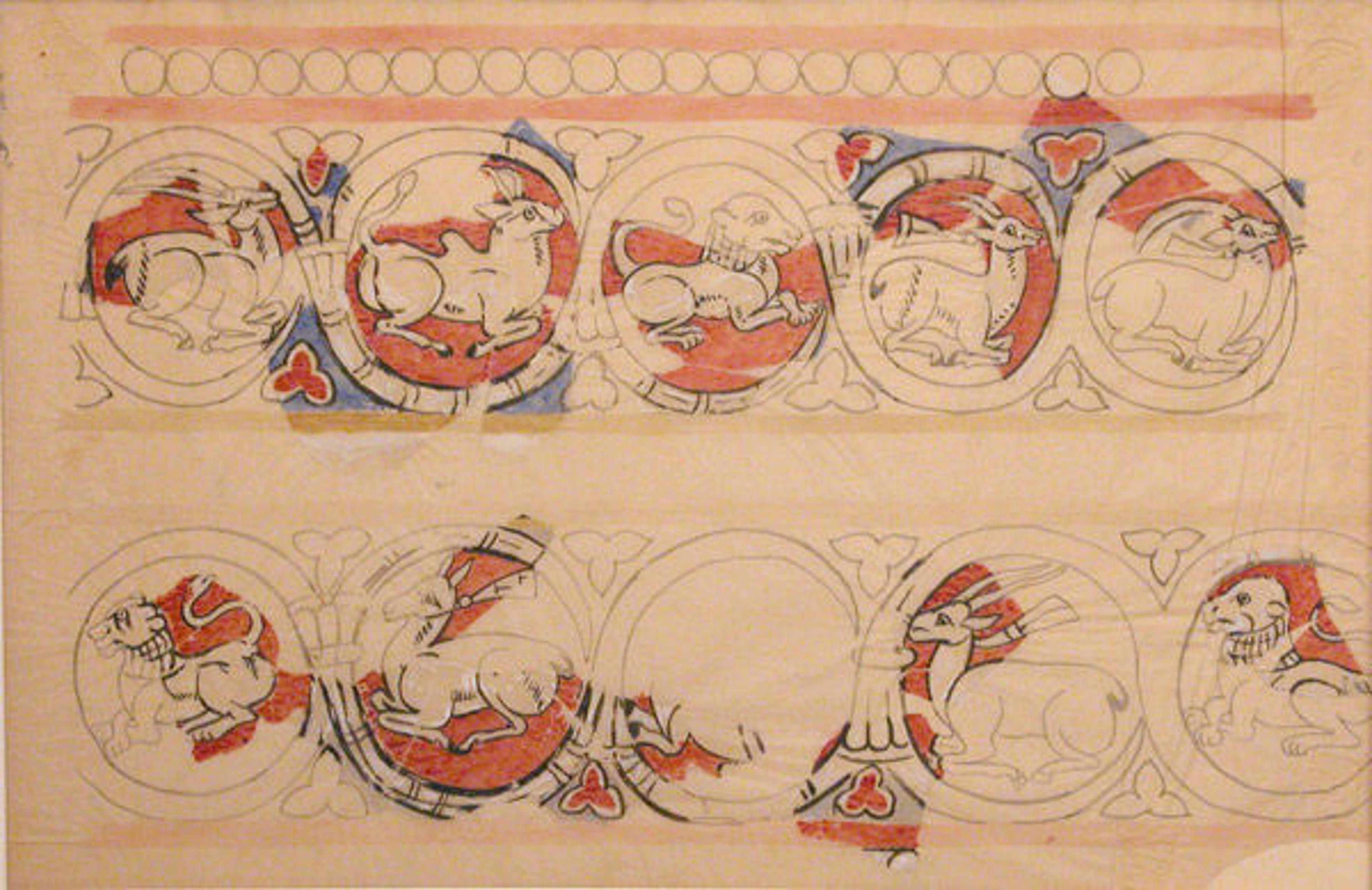The Architectural Ornament of Abbasid Samarra: Newly Released Depictions by Ernst Herzfeld

Two watercolors depicting fragments of wall paintings found at the Main Palace of Samarra. Ernst Herzfeld Papers, The Metropolitan Museum of Art, eeh1050 (left) and eeh1046 (right)
«The Department of Islamic Art is excited to announce the release of new records from the Ernst Herzfeld Papers, part of the department's archival collections. Herzfeld was a German archaeologist and historian considered to be one of the field's founding fathers. The department began to publish records from the Herzfeld Papers online this summer; the records in this latest upload consist of Herzfeld's watercolors and drawings depicting fragments of architectural ornament he excavated at Samarra, the ninth-century capital of the Abbasid dynasty located in today's Iraq.»
These records can be further divided into two groups: watercolors of wall paintings found at the site, and line drawings of carved stucco wall panels excavated there. Herzfeld most likely made these depictions after his excavation of Samarra from 1911 to 1913 and before the publication of his excavation catalogues, Der Wandschmuck der Bauten von Samarra und seine Ornamentik (Berlin, 1923) and Die Malereien von Samarra (Berlin, 1927). A selection of these watercolors and drawings were shown for the first time in a 2002 exhibition at the Met.
Included in the Met's group of watercolors depicting Samarran wall paintings are numerous examples from the early stages of Herzfeld's working process. As he only recorded one painting in situ at Samarra, we assume that the rest of the material was found in a fragmentary state, having fallen from walls or ceilings and broken into pieces. Thus, reconstruction was a major part of Herzfeld's work on the wall paintings. After photographing the various fragments he found, he seems to have first made watercolors of the pieces, which were cut out to replicate the shape of the fragments.
Herzfeld then made copies of these cutouts using tracing paper and pasted them together on larger sheets to create reconstructions of what the original compositions may have looked like. Both of the cutouts shown above were included in the reconstruction below, which suggests a frieze composed of a vine scroll encapsulating antelopes, water buffaloes, and lions. This reconstruction was eventually published along with similar fragments in Die Malereien von Samarra as a color plate.

Reconstruction of wall painting based on fragments found at the Main Palace of Samarra. Ernst Herzfeld Papers, The Metropolitan Museum of Art, eeh517
The Met's project to digitize these watercolors is timely given the renewed scholarly interest in the archaeological material represented in them. A team at the Victoria and Albert Museum, for example, has analyzed the pigments used to create the Samarra paintings for the first time (Burgio et al., 2007). Other scholars have revisited the interpretations of certain paintings based on a review of the archaeological evidence (cf. Rice 1958 and Dahmani 2014). Others still have called into question Herzfeld's reconstructions by comparing his watercolors to photographs of the fragments themselves (Hoffman 2008). This later question is especially important, and now that institutions housing the surviving Samarra paintings are publishing their collections online, one can compare side by side, in color, the archaeological finds to Herzfeld's reconstructions with greater ease.
Just to take one example, the fragment with a lozenge grid depicted below is preserved in the V&A with the accession number A.36-1922.

Colored-pencil sketch of a fragment of a wall painting found at Samarra. Ernst Herzfeld Papers, The Metropolitan Museum of Art, eeh1111
Comparing this fragment to Herzfeld's initial colored-pencil drawing of it preserved in the Met's collection is revealing. While Herzfeld was largely true to the material, as would be expected of such a meticulous scholar, his drawings nonetheless deviate in certain ways from the originals. While Herzfeld's lines are even and regular, the V&A fragment suggests a lighter, freer hand. Sometimes, the red dots in the center of the lozenges overlap with the black lines of the lozenges themselves, and the painters did not always stay within the lines.
Like the watercolors of wall-painting fragments, some of the line drawings included in our collection were later published by Herzfeld. Again, however, the Met's collection of papers is interesting in that it documents Herzfeld's working process. Here, a sketch of part of a wall panel is accompanied by notes breaking the composition down into individual motifs and explaining the method by which they are linked together. It would be worthwhile, perhaps, to compare these notes to the descriptions accompanying the final publications of these drawings in 1923.

Ink drawing of a carved stucco dado excavated at Samarra, accompanied by descriptive notes. Ernst Herzfeld Papers, The Metropolitan Museum of Art, eeh1232
At the moment, 213 documents from this series are online, representing approximately one-third of the drawings and watercolors related to the Samarra finds in the collection. We hope to have the rest up soon. For now, I hope that interested readers will thumb through what is available to appreciate both the artistry of the watercolors and the light they shed on the architectural ornament of a ninth-century Islamic city.
Bibliographic References and Additional Reading:
Burgio, Lucia, Robin J. H. Clark, and Mariam Rosser-Owen. "Raman Analysis of Ninth-Century Iraqi Stuccoes from Samarra." Journal of Archaeological Science 34 (2007): 756–762.
Dahmani, Fatma. "The Painted Jars of Samarra: A Reconsideration." In Beiträge zur Islamischen Kunst und Archäologie 4, edited by Julia Gonnella with Rania Abdellatif and Simone Struth, 95–106. Wiesbaden: Dr. Ludwig Reichert Verlag, 2014.
Herzfeld, Ernst. Der Wandschmuck der Bauten von Samarra und seine Ornamentik. Berlin: D. Reimer, 1923.
——. Die Malereien von Samarra. Berlin: D. Reimer, 1927.
Hoffman, Eva. "Between East and West: The Wall Paintings of Samarra and the Construction of Abbasid Princely Culture." Muqarnas 25 (2008): 107–132.
Rice, David Storm. "Deacon or Drink: Some Paintings from Samarra Re-Examined." Arabica 5 (1958): 15–33.
Related Links:
In Circulation: "The Ernst Herzfeld Papers at the Met: A Digital Resource Documenting the Study of Near Eastern Civilization" (Matt Saba)
Samarra Finds project blog: "Introducing the Ernst Herzfeld Papers in the Metropolitan Museum, Department of Islamic Art" (Rebecca Lindsey)
Watson Library Digital Collections: The Ernst Herzfeld Papers
Freer | Sackler Gallery: Ernst Herzfeld Papers
British Museum Samarra Finds
Victoria and Albert Museum Samarra Finds
Matt Saba
Matt Saba is the Mellon Curatorial Fellow in the Department of Islamic Art.